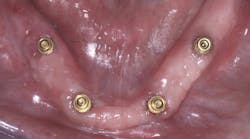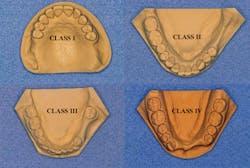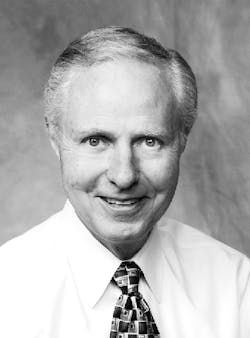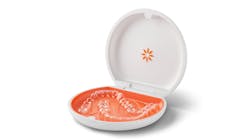Each month, Dr. Gordon Christensen answers a question from our readers about everyday dentistry.
Q: I am concerned about the current clinical challenges that dentists are seeing caused by the increase in peri-implantitis. This growing concern has many ramifications. Among them is the placement of implants in areas of the mouth where conventional dentistry could have been accomplished with known success and a long historical perspective. When are implants mandatory, and when are they elective? What are the situations when implants should be the most appropriate treatment?
A: Dental implants are among the most important innovations to come forth in my long career. Most of them serve patients extremely well and usually outlast the restorative treatment placed over them. However, I, too, am concerned about both the increase in peri-implantitis and the aggressive use of dental implants where proven conventional treatment could have been accomplished.
Nearly 40 years ago, it appeared that implants were going to be our mainstay for many clinical situations. Some conventional techniques were thought to be out-of-date, and implants appeared to be the solution. That concept is now being challenged. Are dentists placing too many implants where other long-proven treatment could possibly be better? I believe this is the case.
- Kennedy class I: Posterior bilateral partially edentulous
- Kennedy class II: Posterior unilateral partially edentulous
- Kennedy class III: Posterior unilateral tooth bounded partially edentulous
- Kennedy class IV: Anterior tooth bounded partially edentulous with the area crossing the midline
Missing teeth within the remaining teeth are identified as modifications.
Kennedy Class I treatment alternatives
(Posterior bilateral partially edentulous)
When most or all of the posterior teeth are gone, chewing is compromised, increased occlusal wear is evident on the anterior teeth, and the face and cheeks usually partially collapse.
Flexible removable partial denture: low long-term acceptability. According to surveys, it is known that patients consider this to be the most desirable removable alternative. These partials are relatively comfortable and low-cost, but they are well known to collapse into the soft tissue due to lack of vertical support, and the occlusion is usually not optimal after even minimal use. Most are difficult to repair, and many dentists consider this alternative only to be transitional.
Removable metal framework partial denture with clasps: low patient acceptability. Unfortunately, as with many partial dentures, these partials are not worn routinely by patients. In class I situations, the partial collapses distally, and occlusion soon becomes less than optimal. Although this problem is not as serious as with flexible partials, long-term use can potentially cause opposing tooth extrusion. A highly disagreeable problem is that clasps often break and repair becomes necessary. These partials are of moderate cost.
Implants on both posterior quadrants and fixed prostheses on each side of the arch: While the cost of this option is high, and surgery is necessary to place the implants, this is a stable option with optimal occlusion and esthetics. There is a high patient and clinical acceptance when cost is not a barrier and the clinical situation is optimal.
Kennedy Class II treatment alternatives
(Posterior unilateral partially edentulous)
This clinical situation has the same characteristics as a Kennedy class I. As with class I situations, removable designs have low patient acceptability. With this option, patients essentially have a chewing side of the arch and a smiling side of the arch, as well as prosthesis material present on both sides of the arch.
Fixed prostheses placed over implants offer cross-arch stability, equal chewing ability on each side, optimal esthetics, and the feel of natural teeth. This alternative is by far the most acceptable to patients and has the most optimal function.
Kennedy Class III treatment alternatives
(Posterior unilateral tooth bounded partially edentulous)
Most patients can chew adequately if they have a Kennedy class III situation, because there are usually many teeth still present. However, their esthetic appearance is often compromised.
Flexible removable partial denture: low long-term acceptability. Although this is reported by patients to be the most desirable removable alternative, these partials have the same negative characteristics as in class I and class II situations. These partials are relatively comfortable, lower-cost, and relatively esthetic. They can be more stable than flexible partials in class I and class II situations because they can rest on teeth if large-rest preparations are planned on the teeth. These removable partial dentures are difficult to repair and considered by many dentists to be transitional.
Removable metal framework partial denture with clasps: low to moderate patient acceptability. This treatment alternative can often be a relatively good one if adequate rests are placed on remaining teeth, but the same negative characteristics described above are present.
Fixed prostheses or crowns placed either on natural teeth or on implants placed in the edentulous areas: the obvious, most adequate, but highest-cost alternative. It is important to note that one implant with a crown on it is about the same fee as a three-unit fixed prosthesis. When observing the continuing increase in peri-implantitis, fixed prostheses placed on natural teeth are looking like the optimal alternative for many situations. The fixed alternatives are by far the most acceptable to patients and have the most optimal function.
Kennedy Class IV treatment alternatives
(Anterior tooth bounded partially edentulous with the area crossing the midline)
Flexible removable partial denture: low acceptability. The partial rocks to the anterior and serves primarily only esthetic needs.
Removable metal framework partial denture with clasps: low patient acceptability. The partial rocks to the anterior, forcing the patient to chew in the posterior.
Implants on the distal ends of anterior edentulous space on each side of the arch and metal-supported partial: moderate to high patient and clinical acceptability. This treatment greatly reduces rock to the anterior, can be esthetic, is lower-cost, and is easier to clean and repair than a fixed prosthesis.
Fixed prostheses placed over implants: This option is usually the most acceptable to patients and has the most optimal function if clinical characteristics allow it.
Edentulous maxilla or mandible
Conventional removable complete denture: moderate to poor patient and clinical acceptability. Maxillary complete dentures are usually accepted relatively well, while very few mandibular dentures are accepted well by patients or are acceptable clinically.
Conventional complete denture supported and retained by implants in the canine and/or other anterior areas (small diameter: 1.8–2.9 mm, or large diameter: 3 mm or larger): usually excellent patient acceptance. This procedure is a life-changing, positive one for mandibular denture wearers and is also very much appreciated by maxillary denture wearers.
Conventional complete removable denture supported and retained by at least four implants—two in the canine areas and two in the posterior segment (figure 2): usually excellent patient and clinical acceptability. These are the obvious major advantages of providing removable prostheses over implants for edentulous patients:
- Esthetics can be superior to fixed.
- Oral hygiene is much easier than fixed.
- Repair is not complicated.
- Cost is significantly less than fixed.
- Implants can be more easily maintained.
- They usually do not require removal of bone.
Fixed prosthesis supported by four or more implants: variable patient and clinical acceptability, ranging from poor to excellent. There are only a few advantages of fixed prostheses for edentulous patients:
- They do not require removal daily.
- They can feel similar to natural teeth.
- They do not move during eating.
- They provide a psychological boost for the patient.
Summary
Implants are a wonderful service when they are needed. However, the increase in peri-implantitis cases should make dentists more cautious when considering implants to be superior to natural teeth. The situations in which implants appear to be the obvious best choice are for patients with resorbed mandibles or maxillae and Kennedy class IV situations (missing teeth in the anterior). Times where implants are elective are for Kennedy class I, II, and III cases. In these areas, various levels of success can be obtained with conventional dental treatments, and existing clinical characteristics dictate the best treatment for the specific situations.
Author’s note: The following educational materials from Practical Clinical Courses offer further resources on this topic for you and your staff.
One-hour videos:
- Restoration of Complete and Partial Edentulism (Item V2503)
- Making Complete Dentures a “Win-Win” Service (Item V2549)
- Diagnosis & Treatment of Failing Implants (Item V2391)
Two-day hands-on course:
- Restorative/Implant Dentistry 3 with Dr. Gordon Christensen
For more information about these educational products, call (800) 223-6569 or visit pccdental.com.









